Collapsed Baltimore bridge chunks appear on incredible 3D underwater images of riverbed – as officials say tangled clutter of metal will make clearing effort more difficult than hoped
Incredible 3D underwater footage reveals parts of the collapsed Key Bridge in Baltimore, which lies at the bottom of Maryland’s Patapsco River.
The U.S. Navy’s Naval Sea System Command (NAVSEA) released four 3D images Monday evening as crews continue to remove steel and concrete to clear and reopen the canal.
The tangle of metal will make the cleanup effort more difficult than hoped, NAVSEA officials said.
“These 3D images demonstrate the enormity of the very difficult and challenging recovery operation ahead,” NAVSEA said in a statement.
The crew of the cargo ship Dali lost power and control on March 26 and crashed into the bridge while eight construction workers were patching potholes in the structure.
Incredible 3D underwater footage reveals parts of Baltimore’s collapsed Key Bridge resting at the bottom of Maryland’s Patapsco River
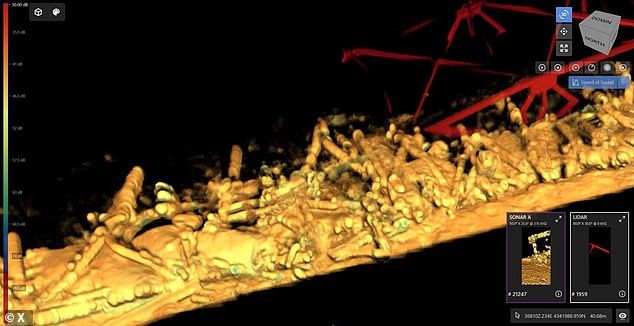
The tangle of metal will make the cleanup more difficult than hoped, officials with the U.S. Navy’s Naval Sea System Command said.
Two workers survived, two bodies were found in a submerged pickup truck and four more men are believed dead. Weather conditions and tangled underwater debris have made it too dangerous for divers to search for their bodies.
“Divers are forced to work in virtual darkness because their visibility, when illuminated, is comparable to driving through heavy snow at night with high beams on,” NAVSEA officials said.
“The water is so murky that divers must be guided by detailed verbal directions from operators at the top of ships viewing real-time CODA images,” she added.
Divers use an underwater sonar imaging instrument known as CODA Octopus, which offers only one to six meters of visibility due to the river’s mud and loose bottom.
There is no usable underwater video of the wreck, authorities said in sharing the 3D images.
One Navy diver said, “You don’t have to take video of something you can’t even see,” according to NAVSEA.
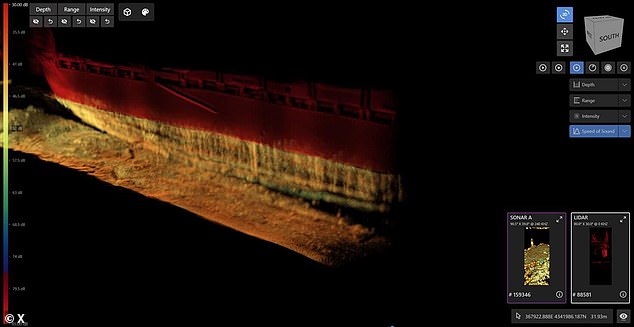
Divers use an underwater sonar imaging instrument known as CODA Octopus, which offers only one to six meters of visibility due to the mud and loose bottom of the river
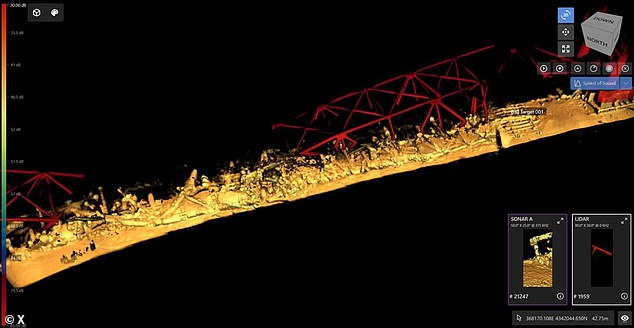
The NAVSEA released four 3D images Monday evening as crews continue to remove steel and concrete to clear and reopen the canal
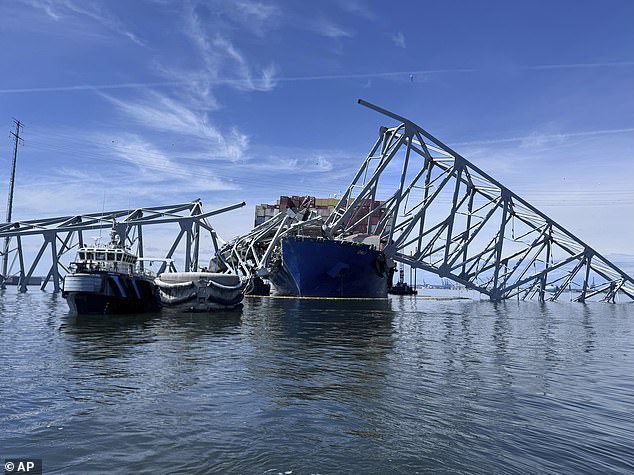
Dive teams examined parts of the bridge and checked the ship over the weekend, and workers in elevators used torches to cut parts of the twisted steel superstructure above water
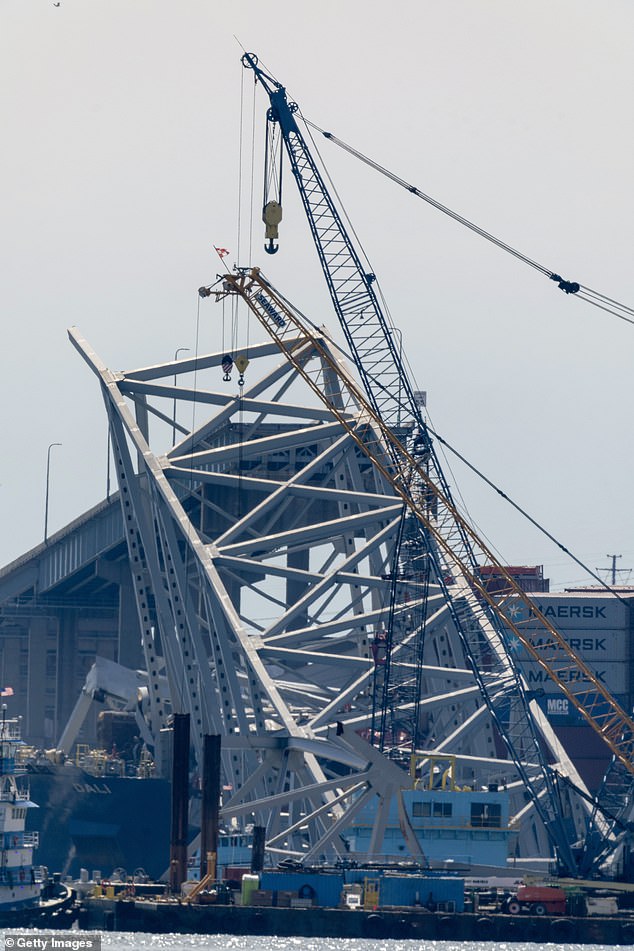
Governor Wes Moore said at a news conference that crews have lifted a 200-ton section of the bridge and have another lift planned for a 350-ton section.
Governor Wes Moore said at a news conference that crews have lifted a 200-ton section of the bridge and have another lift planned for a 350-ton section.
Dive teams examined parts of the bridge and checked the ship over the weekend, and workers in elevators used torches to cut parts of the twisted steel superstructure above water.
Large parts of the superstructure will have to be cut down using floating cranes, which can then be moved onto large deck ships. The pieces can then be transported and probably stored for further examination.
The ship can then be towed to shore or refloated if necessary, depending on how much damage the ship has sustained and whether the hull is damaged.
Officials in Baltimore announced Monday that they will build two temporary alternate canals for commercially essential ships.
Meanwhile, 22 sailors from India remain confined to the Dali since last Tuesday’s disaster while they answer questions from investigators about the catastrophe.
According to Marine Traffic records, the Dali was en route from Baltimore to Colombo, Sri Lanka, flying the flag of Singapore.
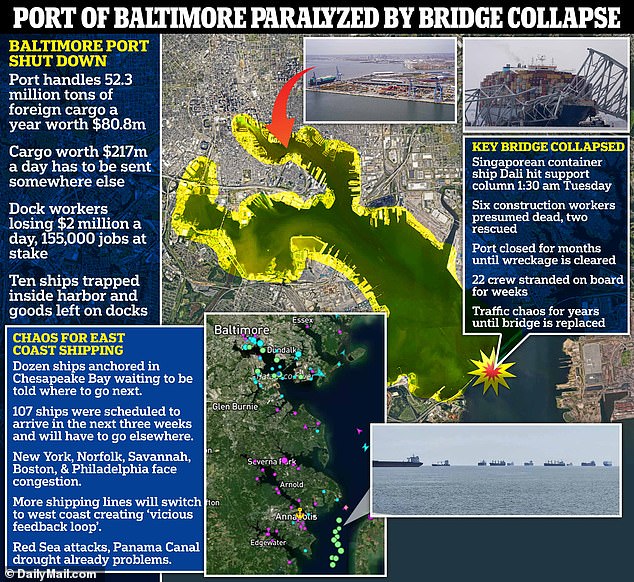
The crew called in a mayday, giving police just enough time to prevent vehicles from entering the bridge, but not enough time to get a crew of eight workers off the structure.
The bodies of four demolition workers are believed to be trapped in the wreckage of the superstructure and may not be found until the bridge is taken apart.
According to diplomats from those countries, the workers came to the Maryland region from Guatemala, Honduras and Mexico.
One worker, 38-year-old Maynor Yassir Suazo Sandoval, came to the U.S. from Honduras nearly two decades ago. His brother described him as an enterprising and hardworking husband and father of two children.
And El Salvador’s Foreign Minister, Alexandra Hill Tinoco, reported on Wednesday on X that a Salvadoran national, Miguel Luna, was among the missing workers.
The collision with a cargo ship that killed six construction workers is sure to create a logistical nightmare, halting ship traffic at the Port of Baltimore and halting freight and commuter traffic.
The port is an important shipping hub on the east coast. The bridge spans the Patapsco River, which huge freighters use to reach the Chesapeake Bay and then the Atlantic Ocean.
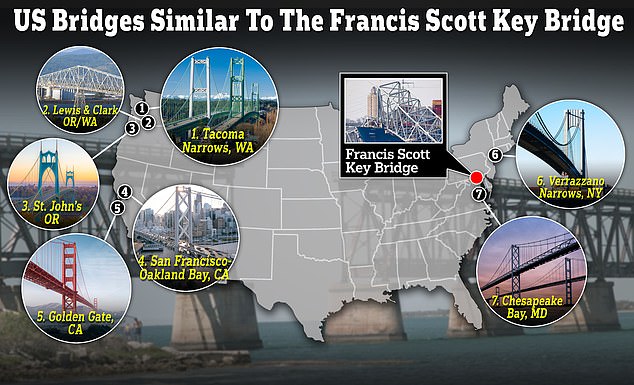
According to the latest data from the U.S. Federal Highway Administration, several other bridges are vulnerable to a similar future tragedy. Most of it is older than the Key bridge
Last week, the Key Bridge was described as “fracture critical” by the National Transportation Safety Board.
In addition to the lack of protective structures around the supporting columns, there was also a lack of redundancy. When a few pillars were destroyed, there was nothing to support the weight they had been holding up.
Redundant piers may have helped, but engineers rarely design such redundancy into their construction, making collisions extremely unlikely and outweighing the additional costs such a design would entail.
Tragically, this meant that the bridge’s design was ‘fracture critical’, meaning one fault destroyed the bridge.
Eight other bridges in the country with a similar clearance of 55 meters have been classified as ‘fracture critical’.
According to Wall Street JournalThese bridges include: Tacoma Narrows Bridge, Washington; Lewis and Clark Bridge, Oregon-Washington; St. Johns Bridge, Oregon; San Francisco-Oakland Bay Bridge, California; Golden Gate Bridge, San Francisco; George Washington Bridge, New York-New Jersey; Verrazzano-Narrows Bridge, New York and Chesapeake Bay Bridge, Maryland.
